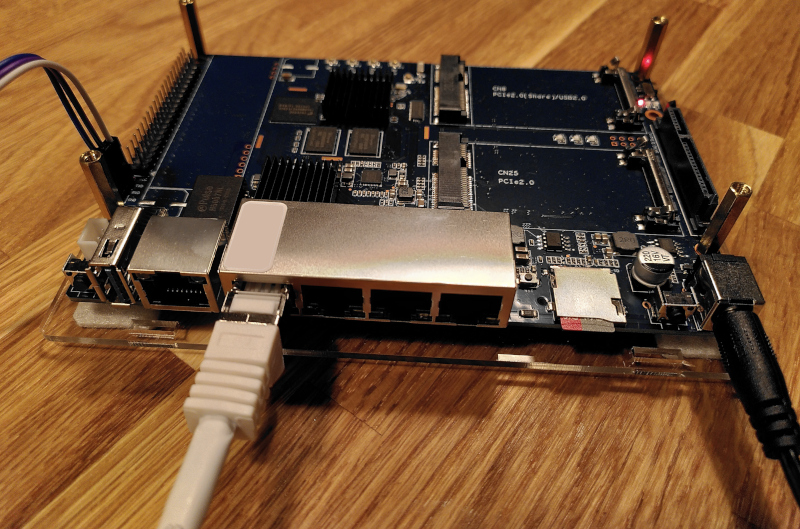I’ve got my hands on a brand new Banana Pi BPi R64 with a dual-core 64-bit ARM Cortex. The fact that it has multiple Ethernet ports makes it the perfect toy to build a router. This article covers the very basics of how to get started with the device. This article is intended as a more verbose version of the official getting started guide.
Download Linux image
Links to prebuild images for the Banana Pi can be found in the
forum. It is very easy to get lost in the large
number of different boards and OS configurations spread over many threads. You
can download a
suitable image for the R64
r64_buster_newatf_5.10.img.gz
from the Google Drive of the maintainers.
Copy to SD card
The Banana Pi ecosystem has a dedicated, handy utility to copy drive images to an SD card. To install the tool, run
sudo apt install pv
curl -sL https://github.com/BPI-SINOVOIP/bpi-tools/raw/master/bpi-tools | sudo -E bash -
And finally, copy the image:
gzip -d r64_buster_newatf_5.10.img.gz
sudo bpi-copy r64_buster_newatf_5.10.img <device path>
Put the SD card into your Banana Pi.
Attach serial console
At this point, I expected the device to be ready to SSH into the box. However, by default, the Banana Pi does not enable the network interfaces at this stage.
The only way to get access is with a serial-to-usb converter. If you are lucky, such a converter came bundled with the Banana Pi. The image in the official guide might help where to connect the USB interface.
If the output of the converter is labeled with GND, TXD, and RXD, it’s
usually (unless stated otherwise) your job to ensure that the TXD of the
converter connects to the RXD
of the BananaPi and the other way round. In practice, this means you need to
cross the wires for TXD and RXD between Pi and converter:
| Banana Pi Label | Converter Label |
|---|---|
TXD |
RXD |
RXD |
TXD |
GND |
GND |
There are several software options to install on your host system to connect to the serial terminal via USB. My recommendation is minicom:
sudo apt install minicom
Boot
Connecting the serial-to-usb converter does not power the device. Connect the
Banana Pi to an external 12V power supply to boot it. Start minicom on your
host system to monitor the boot process. The minicom defaults are usually fine. (To
quit minicom, press CTRL + A followed by
X.) Once the Banana Pi boot process succeeded, you should see
Debian GNU/Linux 10 bpi-r64 ttyS0
bpi-r64 login:
The default username is root; the default password is bananapi.
Network
Connect the Banana Pi to your local network via the leftmost of the four connected LAN ports on the board.

In your system, this port is called lan0.
Open /etc/network/interfaces with your favorite text editor (i.e., vi) and
change the entire lan0 block to
iface lan0 inet dhcp
This will make your Banana Pi connect to the local network with DHCP.
This might also interest you
